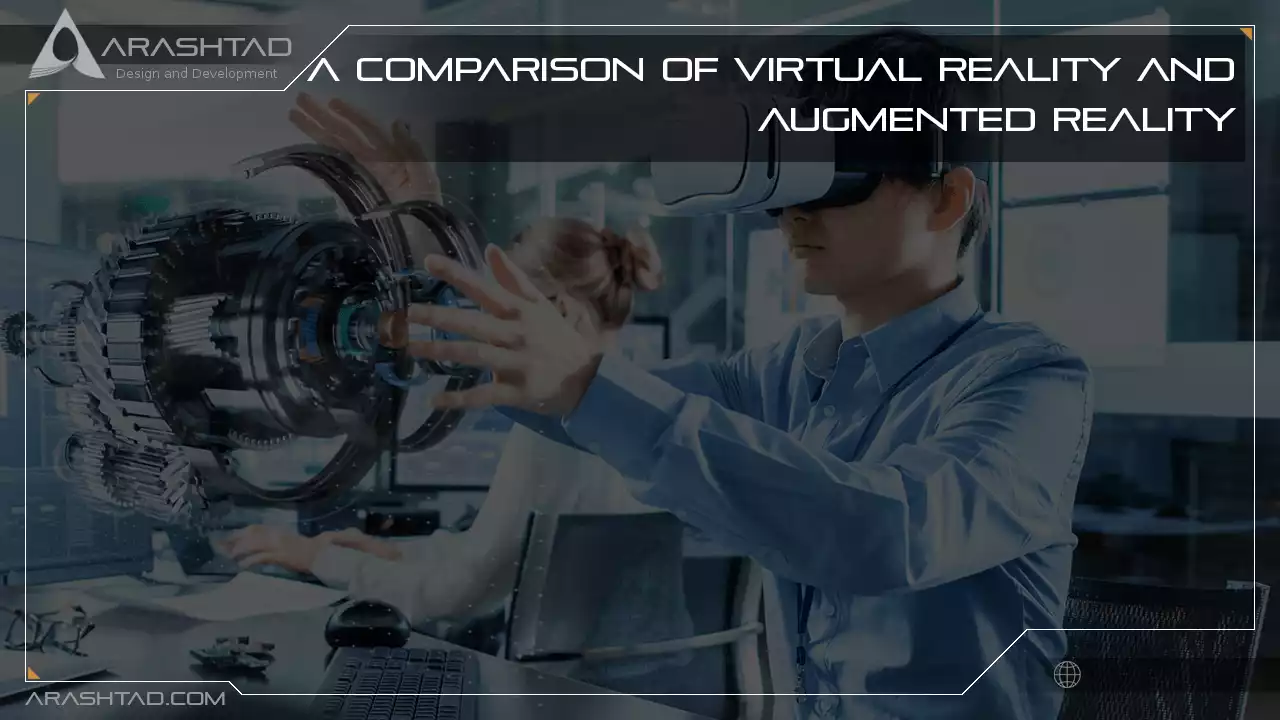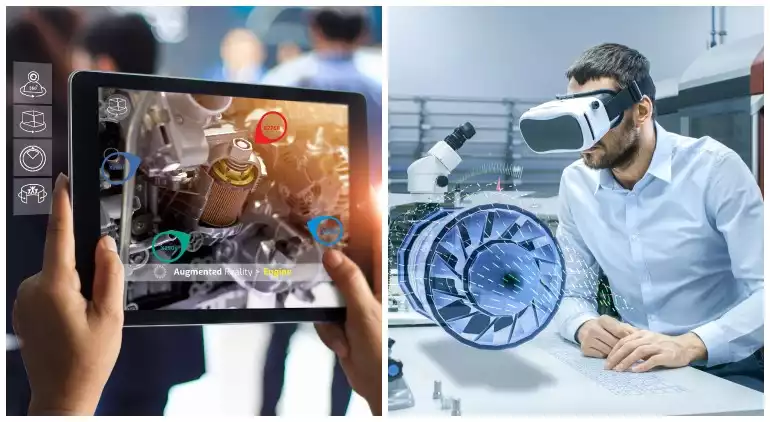A Comparison of Virtual Reality and Augmented Reality
An increasingly digital world emphasizes the importance of augmented reality and virtual reality. Although they are two different technologies, they are often used as synonyms. In this tutorial, we will discuss the benefits and challenges of Augmented Reality versus Virtual Reality, as well as their differences and similarities.
Virtual Reality: What Is It and How Does It Work?
A virtual reality system generates 3D digital images and videos to provide users with real-time visual experiences. It creates the illusion of being immersed in a 3D digital environment that is life-size. VR systems use computer vision and advanced graphics to add depth and reconstruction of the scale and distance between static two-dimensional (2D) images. They are used to create 3D photos and videos that reproduce the real or imaginary world. In this way, a real-life environment is replaced by a simulated one, creating an immersive experience that makes you feel like you are part of that computer-generated digital environment. Using computers and sensory devices, users can explore and control 3D environments. Since VR headsets have lenses with sensors, users can experience virtual content and interact with it naturally.Modern VR devices are more advanced than 3D ones. They feature real-time tracking features that allow users to explore their VR environments using all five senses at once. The use of virtual reality is widespread in entertainment, education, and business applications.
Augmented Reality: What Is It and How Does It Work?
A technology known as augmented reality (AR) enhances the perception of the user by providing them with a live view of the real world with digital information, such as images, sound, videos, and other virtual details. AR augments the environment by allowing virtual elements to interact with real objects to create intended meanings. This technology provides additional information about the real world by coexisting with informatively designed virtual environments. AR is usually produced with common devices, such as smartphones with cameras, instead of specialized equipment.By calculating the position and orientation of objects relative to other objects, AR systems superimpose virtual three-dimensional (3D) objects on real-world objects in real-time. A common use of AR technology today is in conjunction with mobile phone technologies, including GPS, 3G, and 4G, as well as remote sensing. A mobile screen, augmented reality glasses, or any other display device can display this image. The use of AR systems is widespread in the photography, editing, and interior decoration industries, as well as in video games like Nintendo’s Pokémon Go and in virtual dressing rooms for fashion shows.
Advantages of VR:
1- VR creates a realistic environment that allows users to explore and experiment with an interactive artificial environment. VR is more immersive than AR in terms of immersion and a sense of presence. It gives users the impression that they are actually in a different world when they play games or watch videos.2- Virtual reality makes learning and practicing easier, safer, and more comfortable. One of the best benefits of the technology is the ability to conduct training and practice potentially dangerous real-world operations like surgery, plane flight, or combat without risk.
Disadvantages of VR:
1- One of the significant disadvantages of virtual reality is that it never works as well as practice and working in the real world regarding training. In other words, even if a user performs well with simulated tasks in a 3D virtual reality environment, there is no guarantee that they will perform the same tasks in the real world as well.2- VR systems are expensive, so not everyone has the means to afford them. VR devices are not cheap, and despite the decrease in price, they are still not widely used. Since there are so few VR systems available, customer options are limited. Low adoption means there are few VR systems out there.
3- VR poses several health concerns. It could hurt users’ health. The technology must be improved before it can be used without causing side effects such as headaches, nausea, and blurred vision.
4- progressive escapism became a long-term commonplace among VR users. They began to live in virtual environments instead of dealing with reality. After spending significant amounts of time in the virtual world, they tended to enjoy it more, which led them to use VR even more, resulting in a feeling of isolation from the real world.
Advantages of AR:
It is usually compared to VR in its pros and cons, and AR can provide users with a completely new, interactive experience.1- One of the most significant advantages of AR is that it is a great educational tool. By providing an enhanced experience, AR has the potential to increase users’ knowledge and awareness. It offers individualized learning, fostering the learning process. AR technology allows users to share experiences with others in real time over long distances.
2- Since AR systems usually do not have device limitations, their applications are very easy to use. As AR requires no head-mounted display, smartphone users are given more freedom and marketing opportunities.A user just points their camera at an object to see what the app does with it. However, high bandwidth is still needed to create life-like and high-resolution objects.
3- There are many applications for AR today, including gaming, marketing, education, healthcare, navigation, design, and entertainment (Snapchat, Google Lens, IKEA Place, et cetera).
Disadvantages of AR:
1- It may seriously affect the overall augmented reality principle due to the lack of privacy and security.2- Aside from its other disadvantages, AR technology remains lowly adopted and used on a day-to-day basis. 3D systems cannot produce and support 3D visualizations in real-time, slowing down its spread. Developing, implementing, and maintaining projects and applications based on AR technology is still quite complex and expensive.
3- Over-engagement with AR can cause health issues. Too frequent or intense AR pastimes can cause eye problems, obesity, mental health issues, etc.
Mixed Reality (MR):
A mixed reality (MR) environment combines virtual and physical elements to create a new environment that can interact in real-time with both. It is a hybrid of augmented reality (AR) and virtual reality (VR). Virtual reality immerses users entirely in a virtual world, whereas augmented reality overlays digital content onto the real world without considering its unique and dynamic structure. In contrast to VR systems, which immerse users in a completely virtual world, MR systems continuously collect new information about their environment. MR fuses the virtual and physical worlds into a single entity. One of the most exciting aspects of MR is its rapid growth. It has been used in many different areas, including entertainment, education, design, healthcare, military training, marketing, and remote working.A further connection between AR, VR, and MR is extended reality (XR), which merges digital and physical reality and combines human-machine interactions via wearable devices.
Conclusion:
As a result of this tutorial, you better understand the differences between AR and VR. AR involves overlaying digital content such as 3D holograms and animations onto or over real-time user environments, whereas VR is about displaying information such as travel and statistics. As a result of mixed reality, the user may not be able to interact with and control it. Using VR, real-world environments are replaced by virtual ones, and users are immersed in the virtual environment and can control and manipulate it. Augmented reality and virtual reality are equally used in gaming, education, health, and employee training. AR apps require users to capture their real-world environments, whereas VR apps do not. If the headsets have a tracking feature, VR systems can provide real-time navigation of real-world environments.Download this Article in PDF format

Arashtad Custom Services
In Arashtad, we have gathered a professional team of developers who are working in fields such as 3D websites, 3D games, metaverses, and other types of WebGL and 3D applications as well as blockchain development.
Arashtad Services
Drop us a message and tell us about your ideas.
Fill in the Form
Blockchain Development


